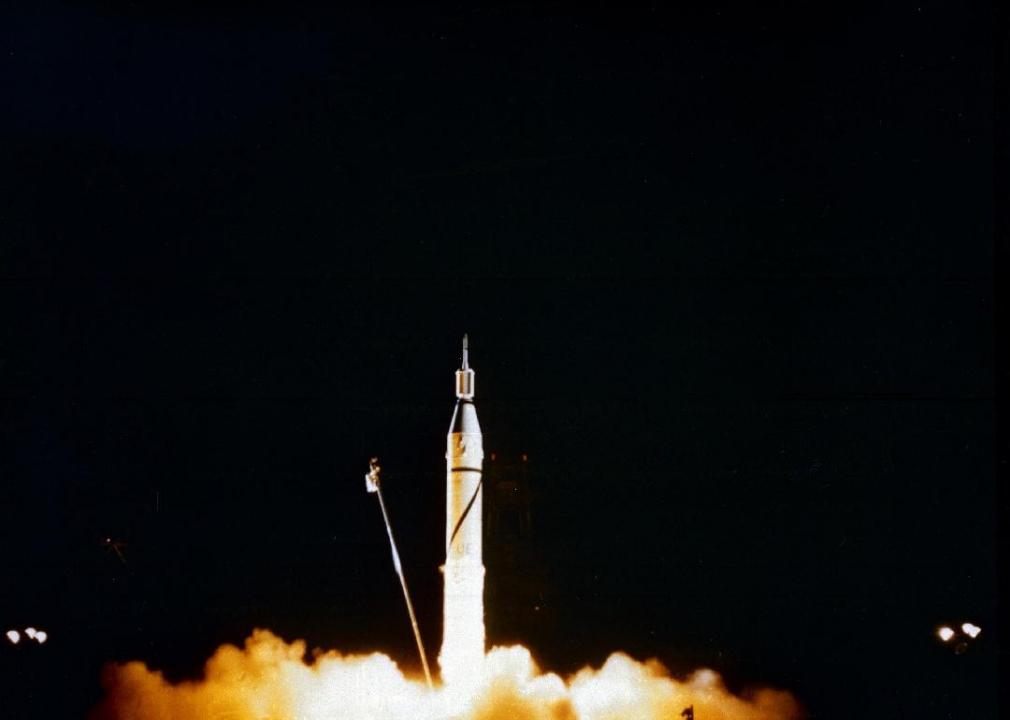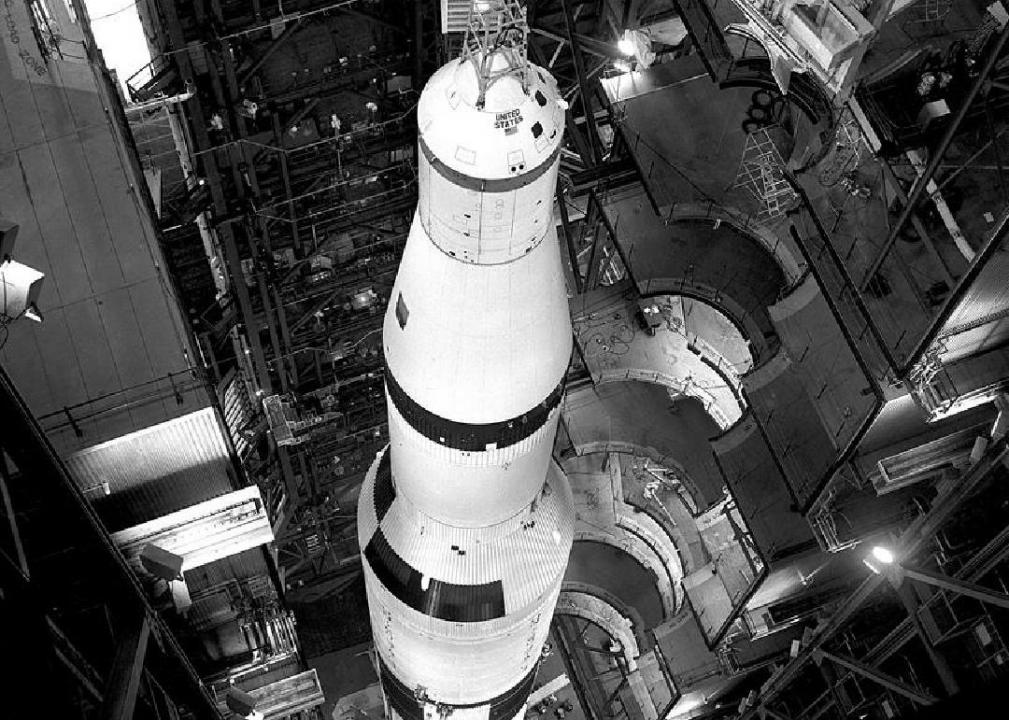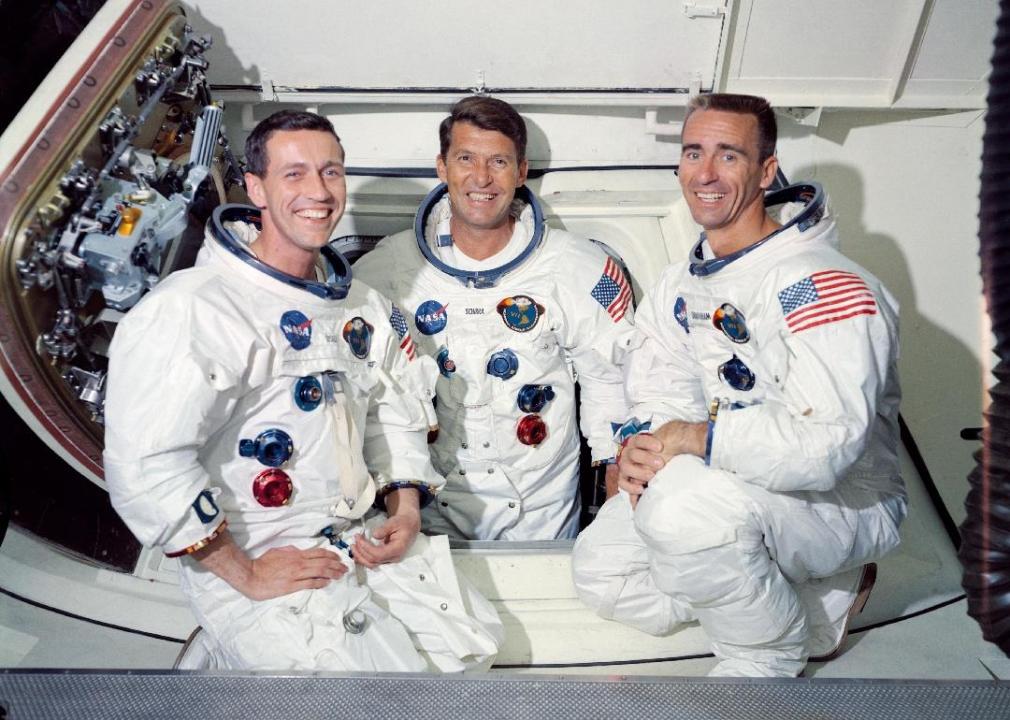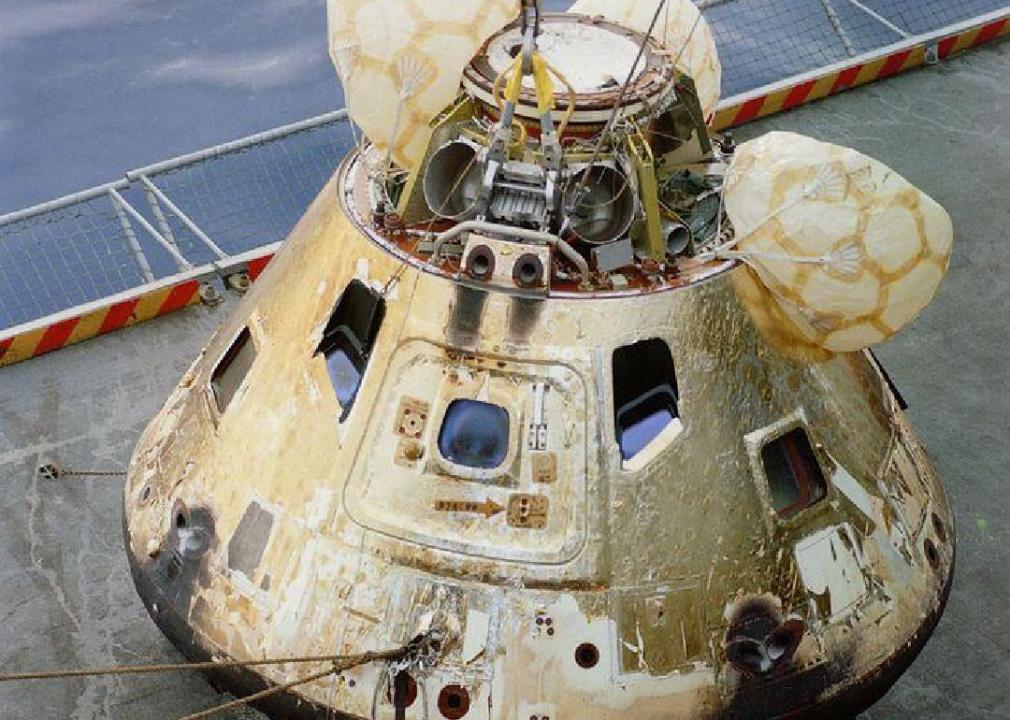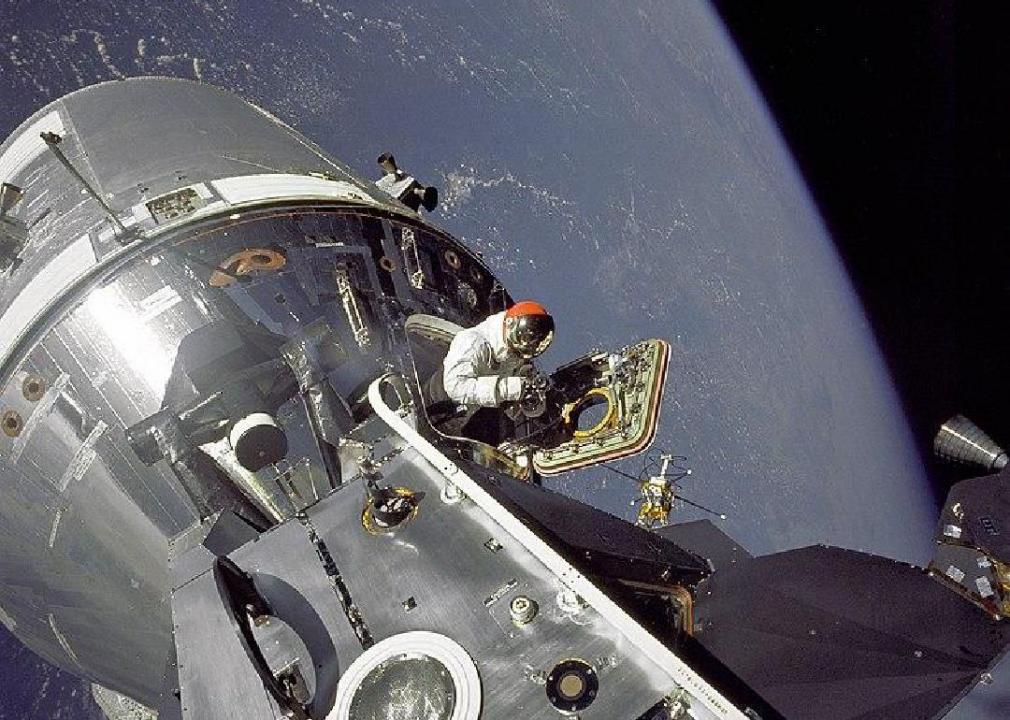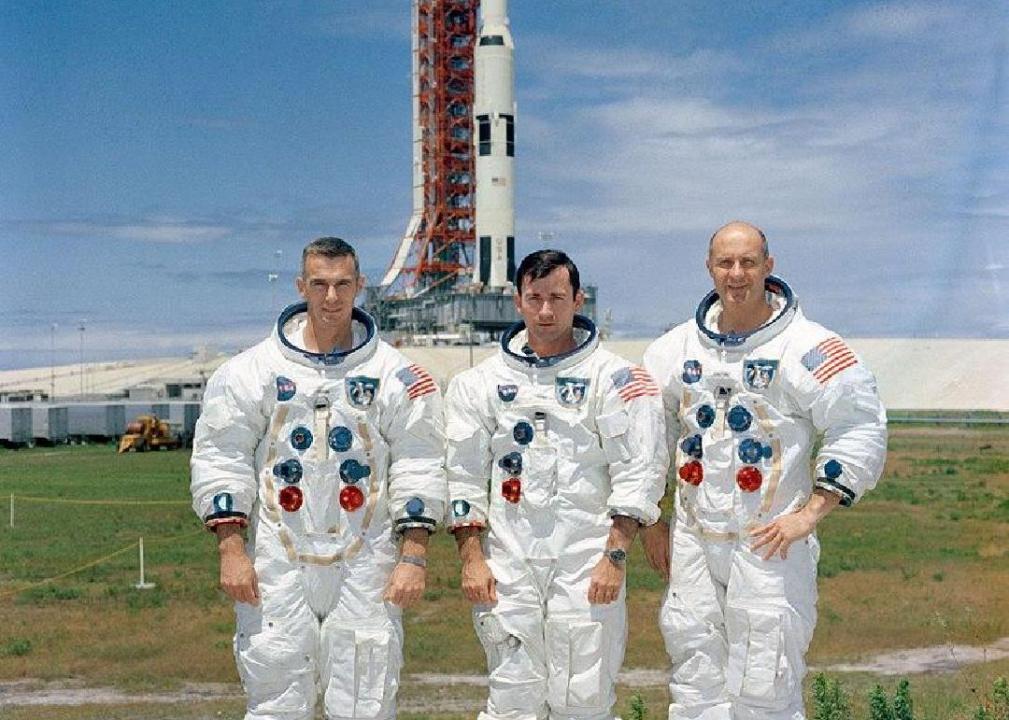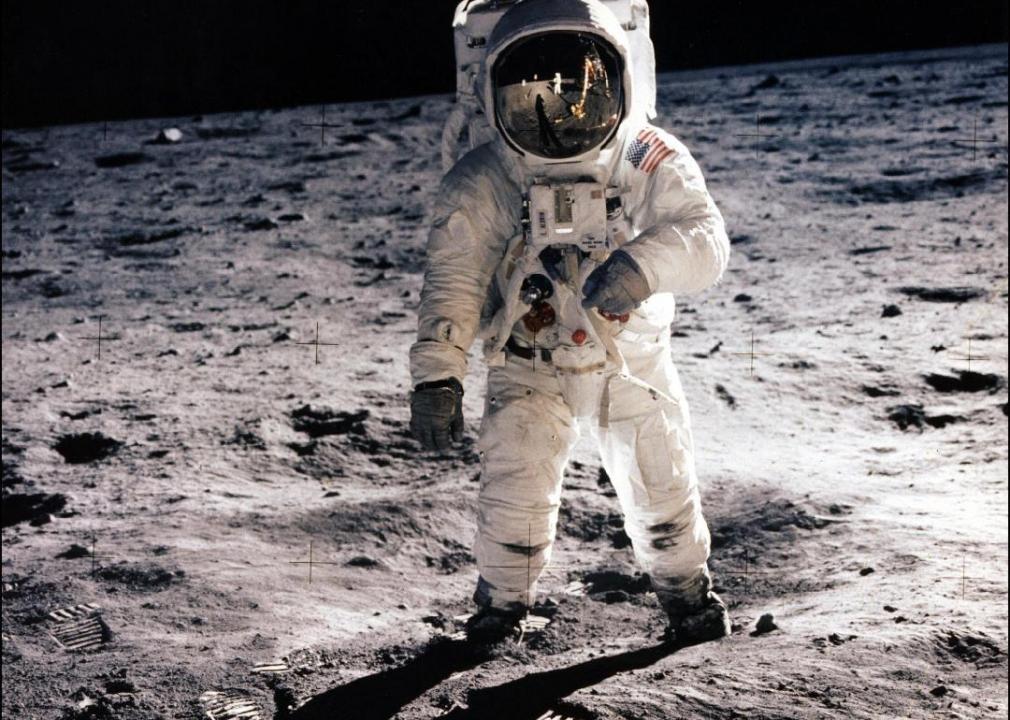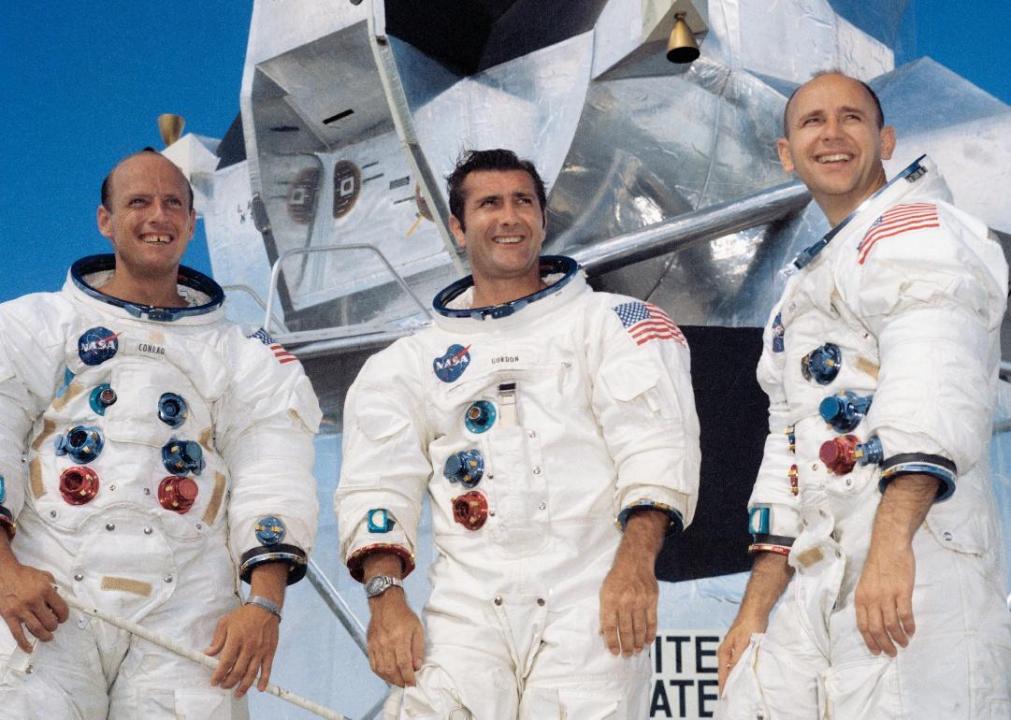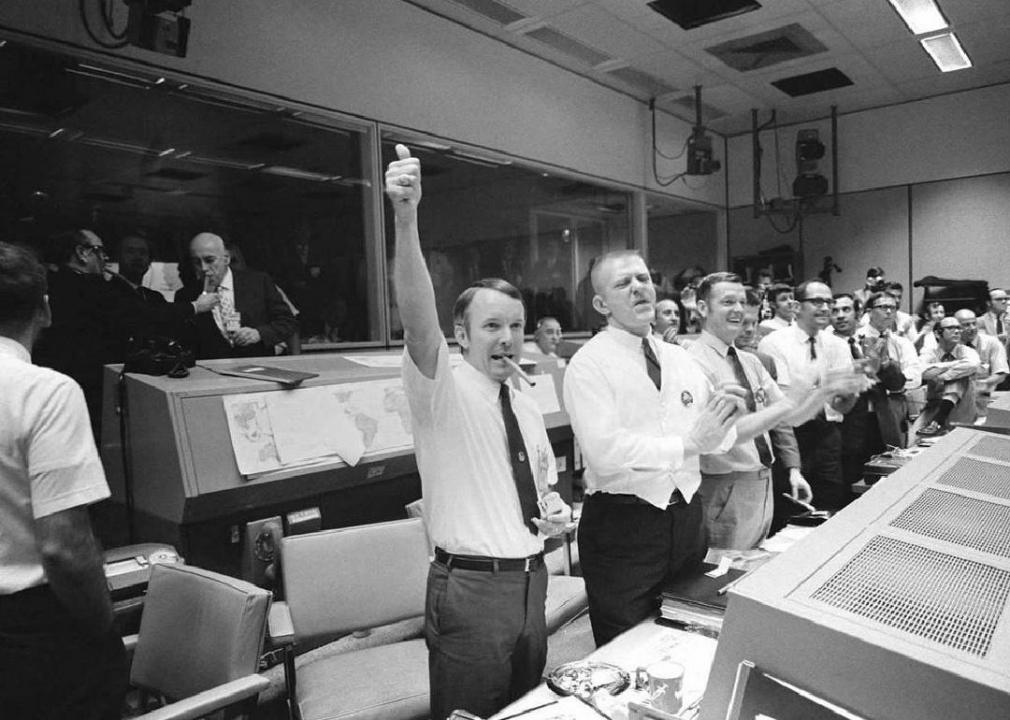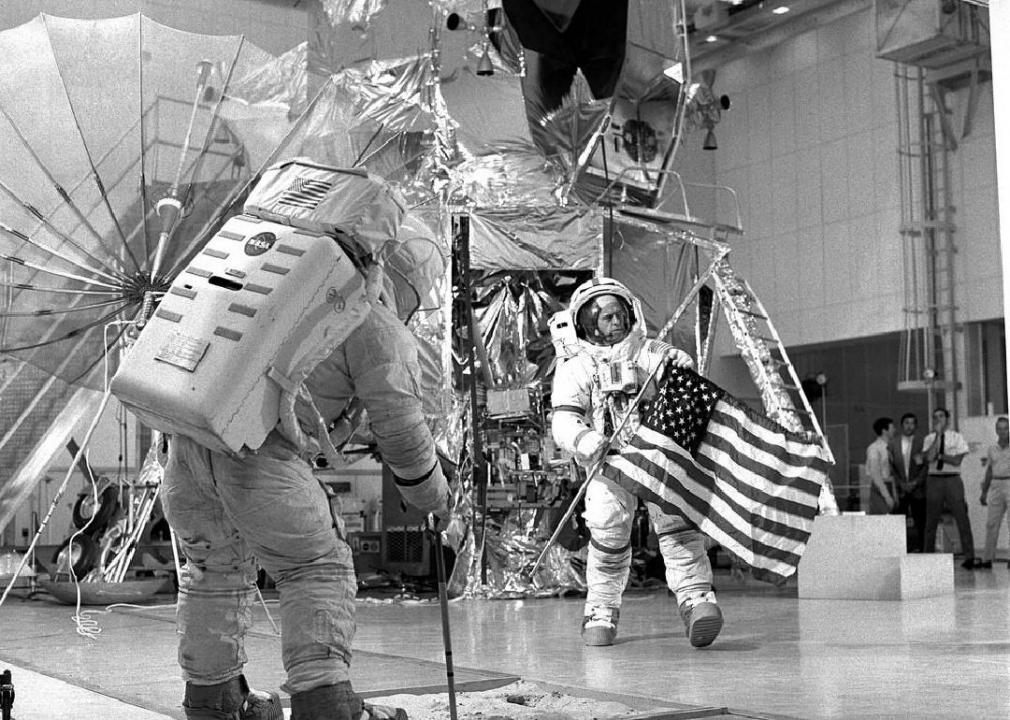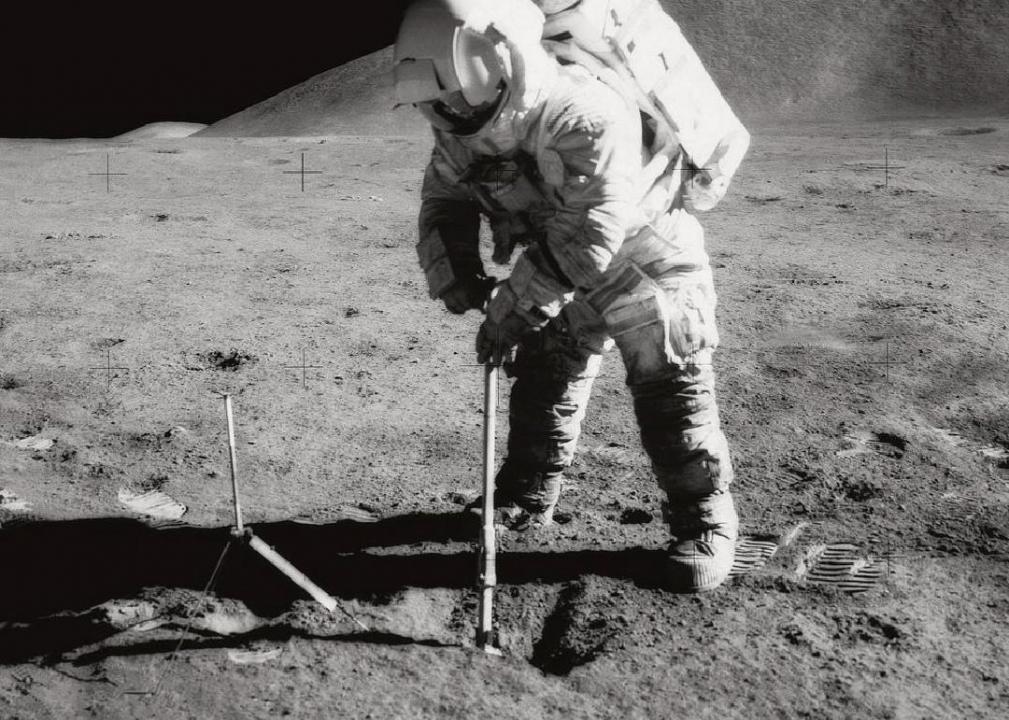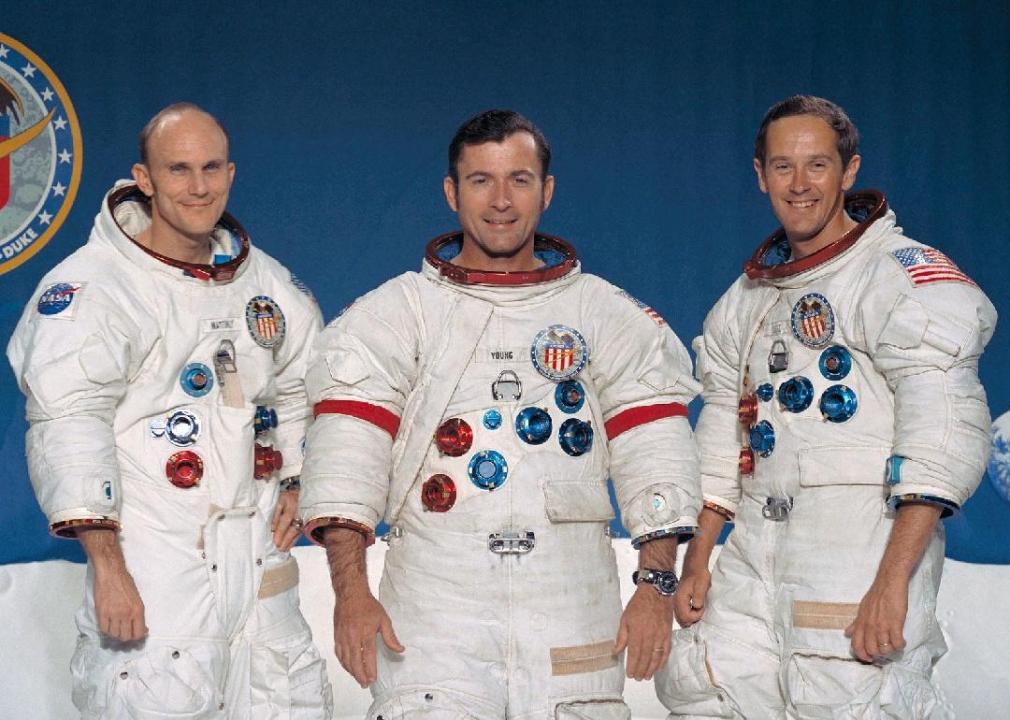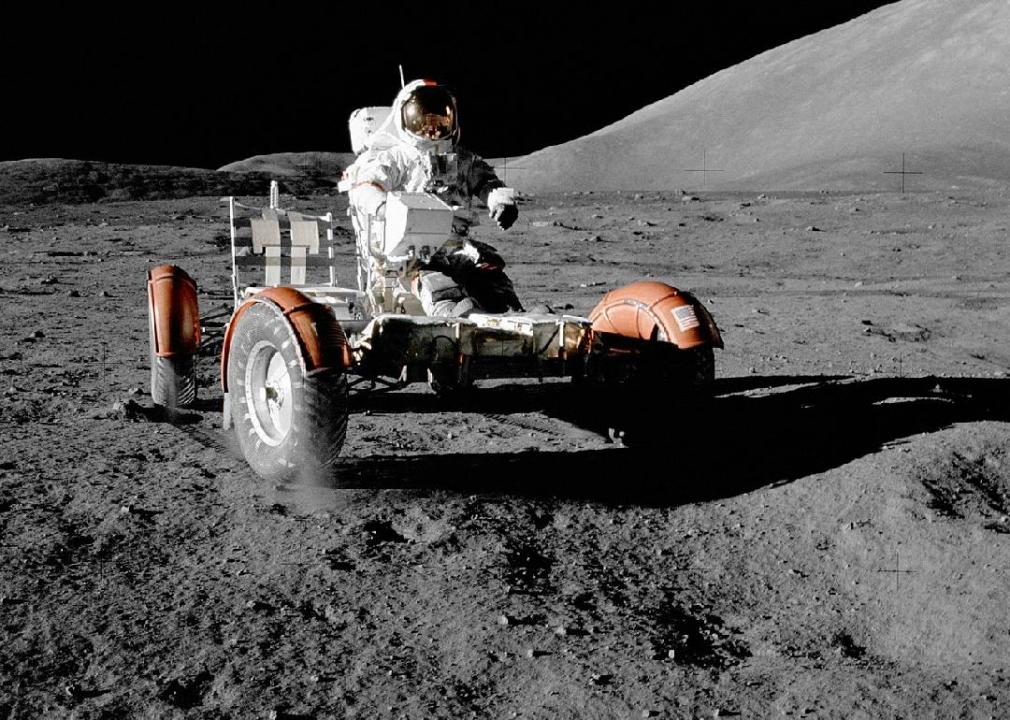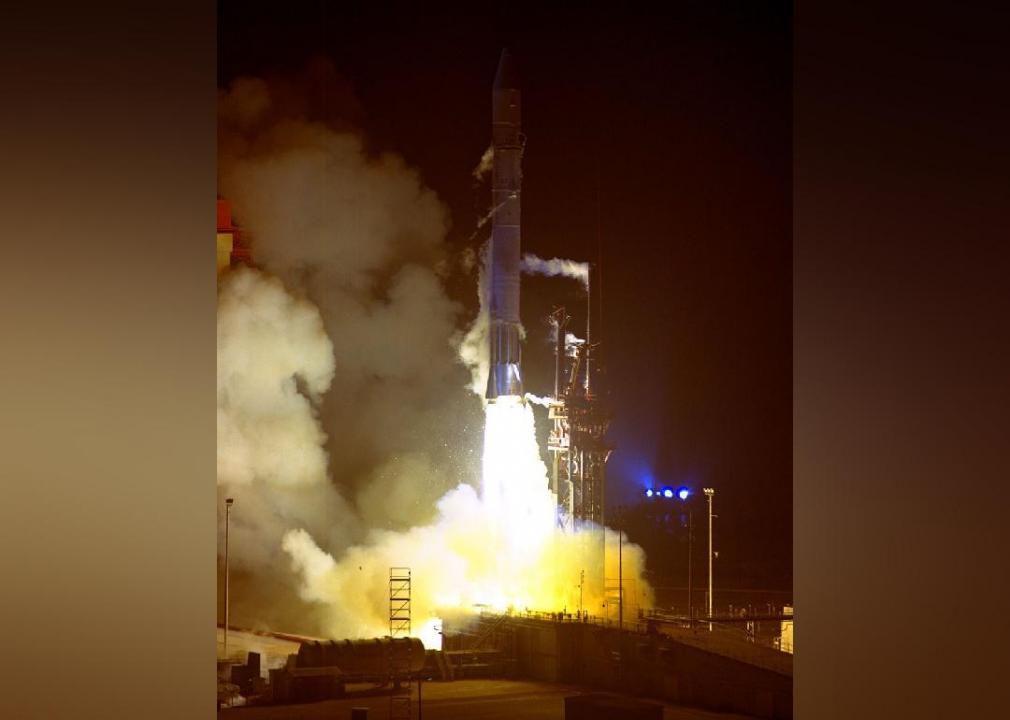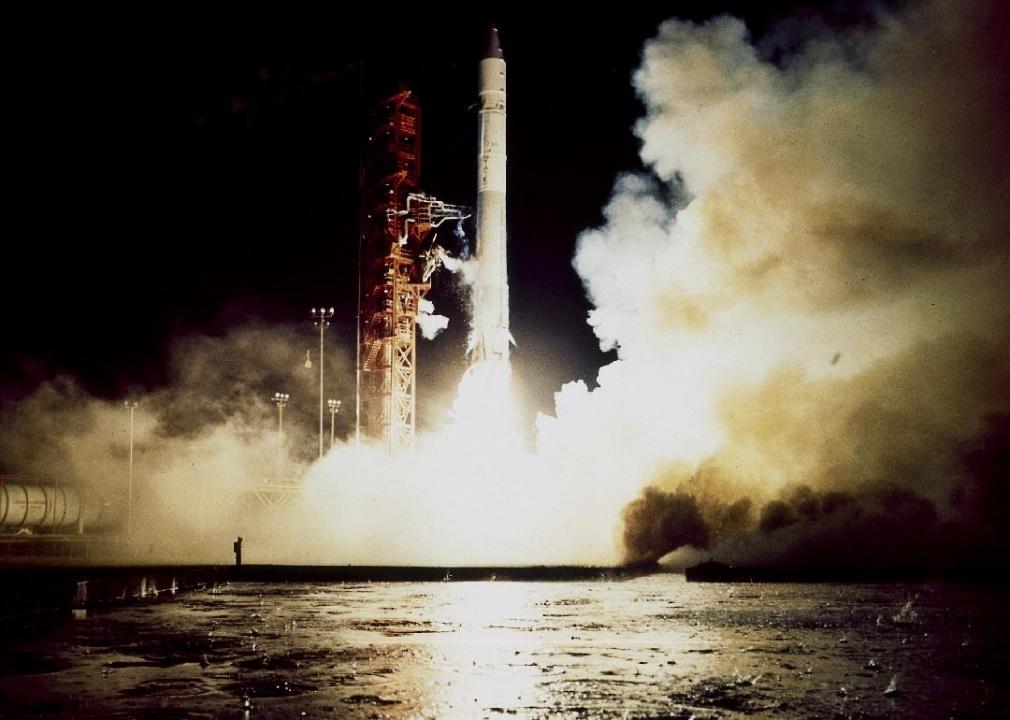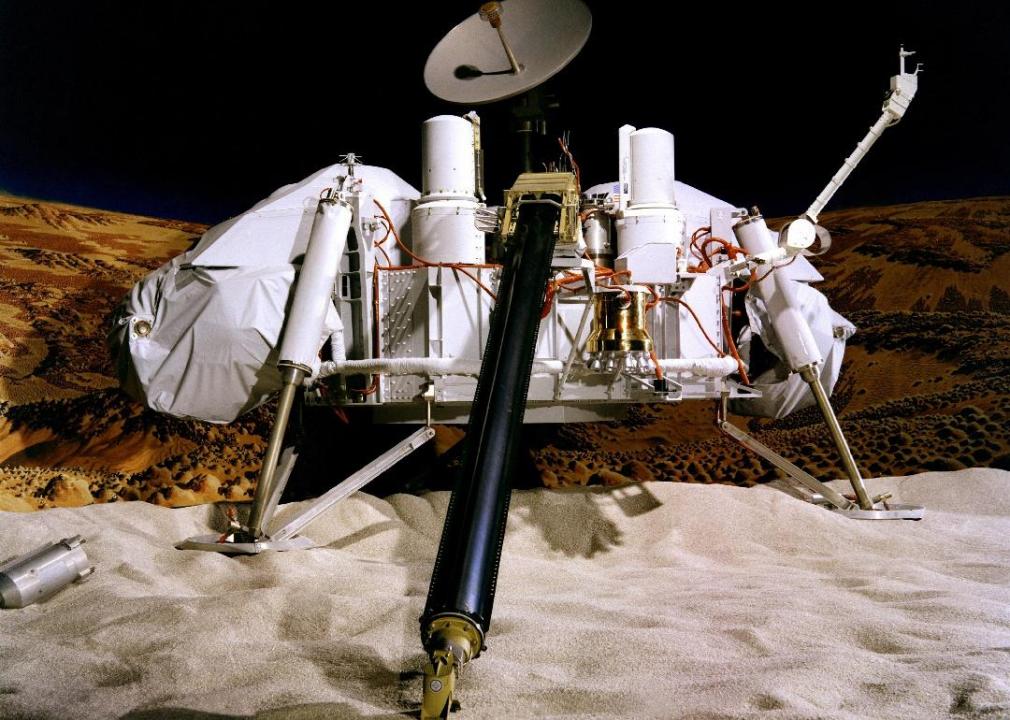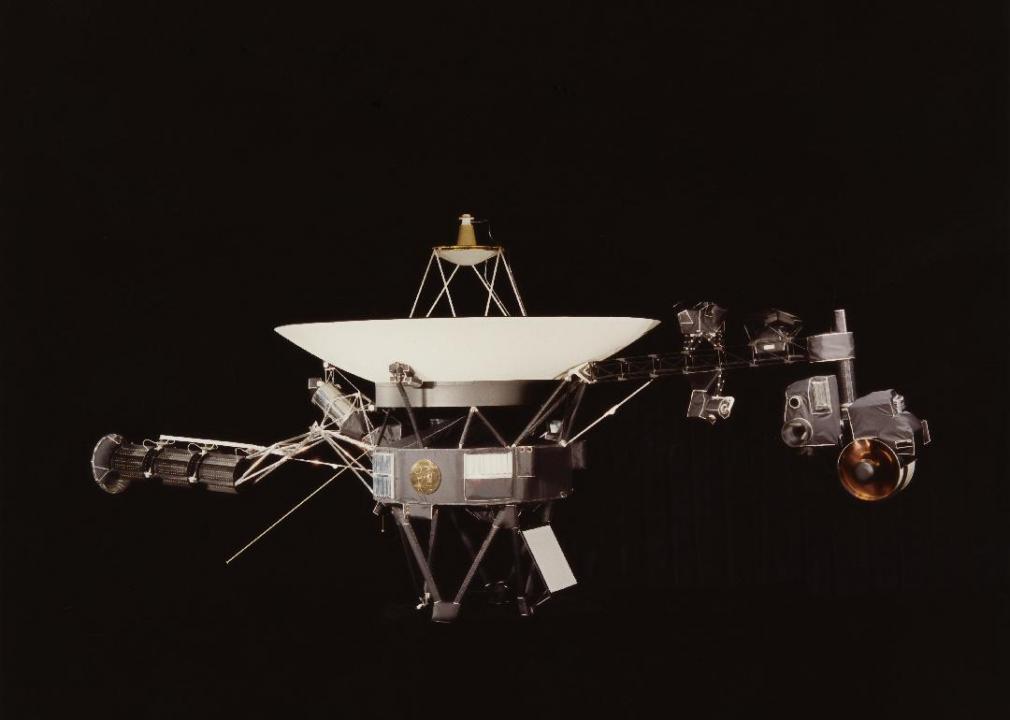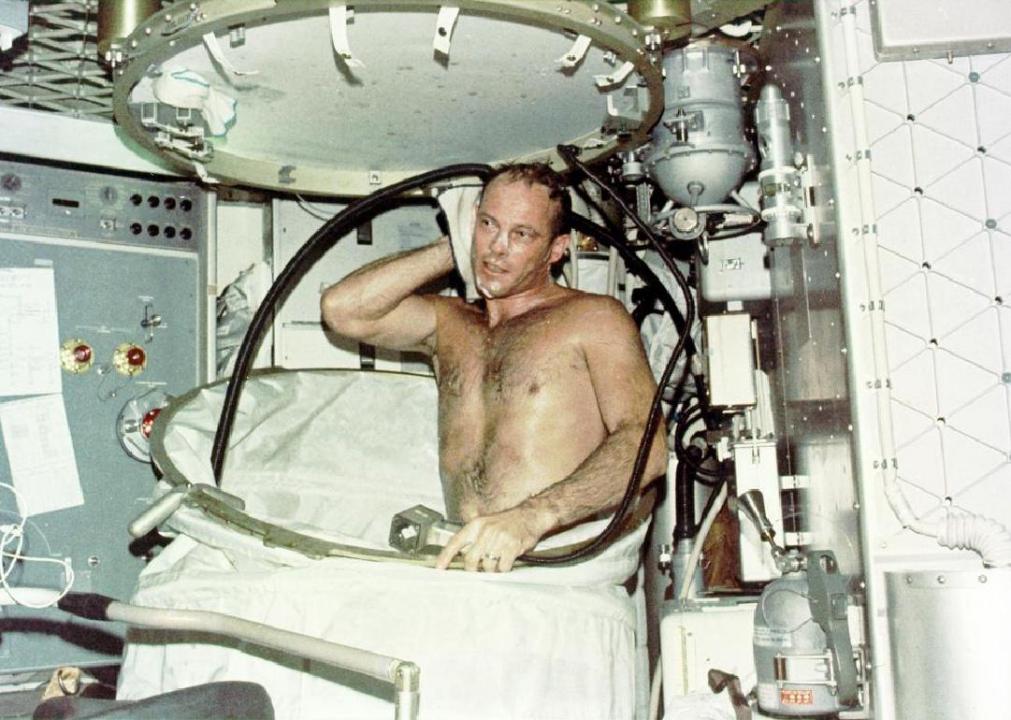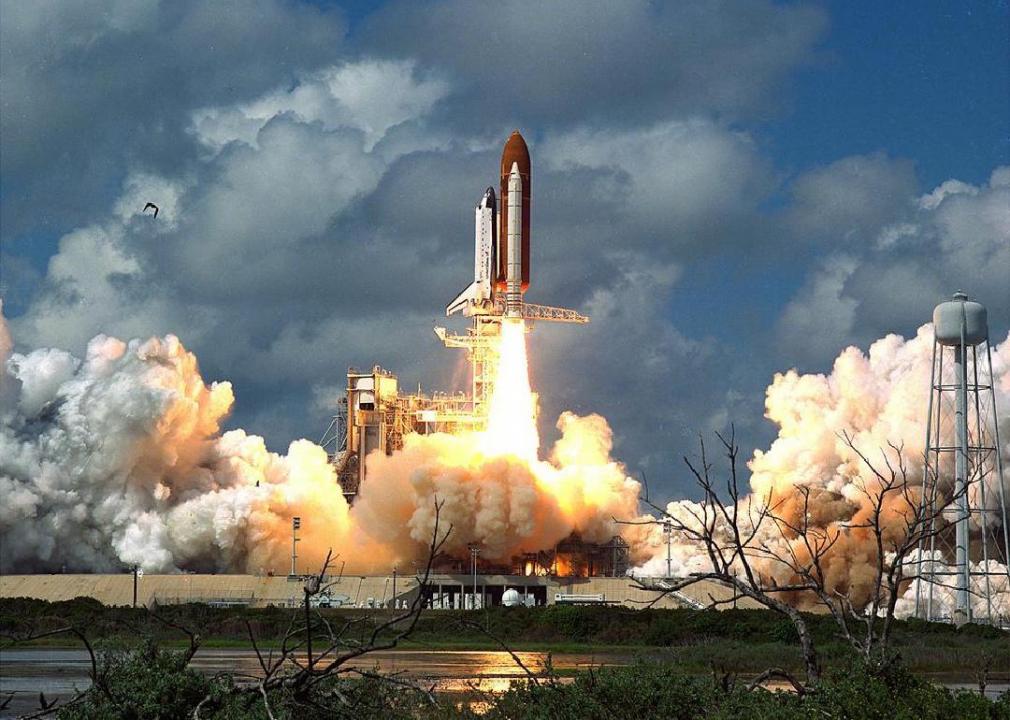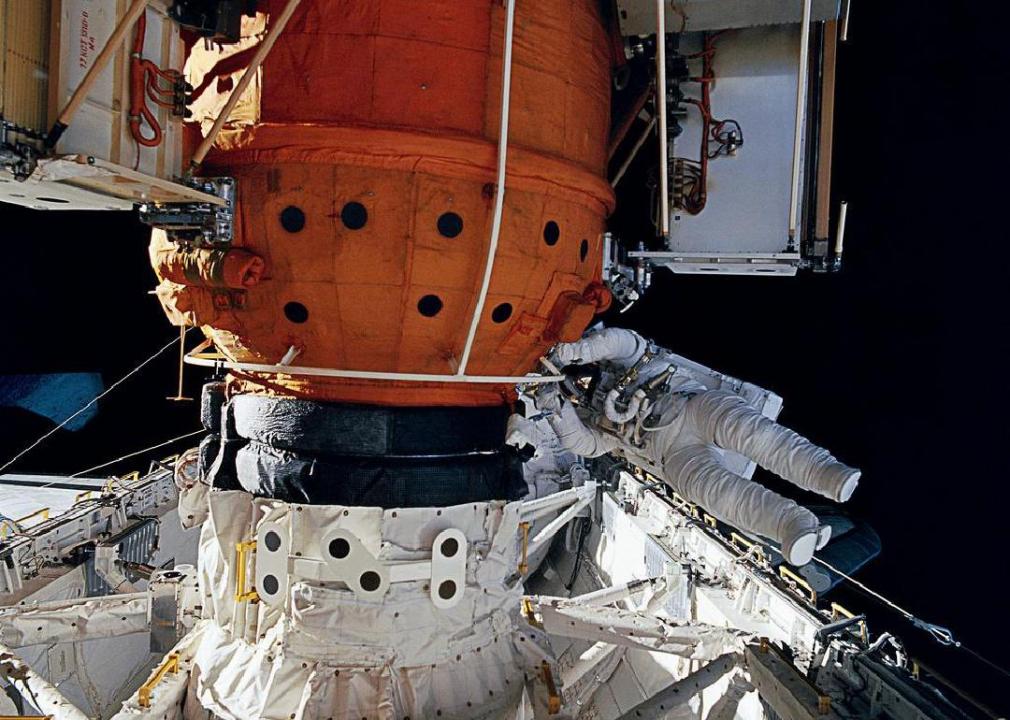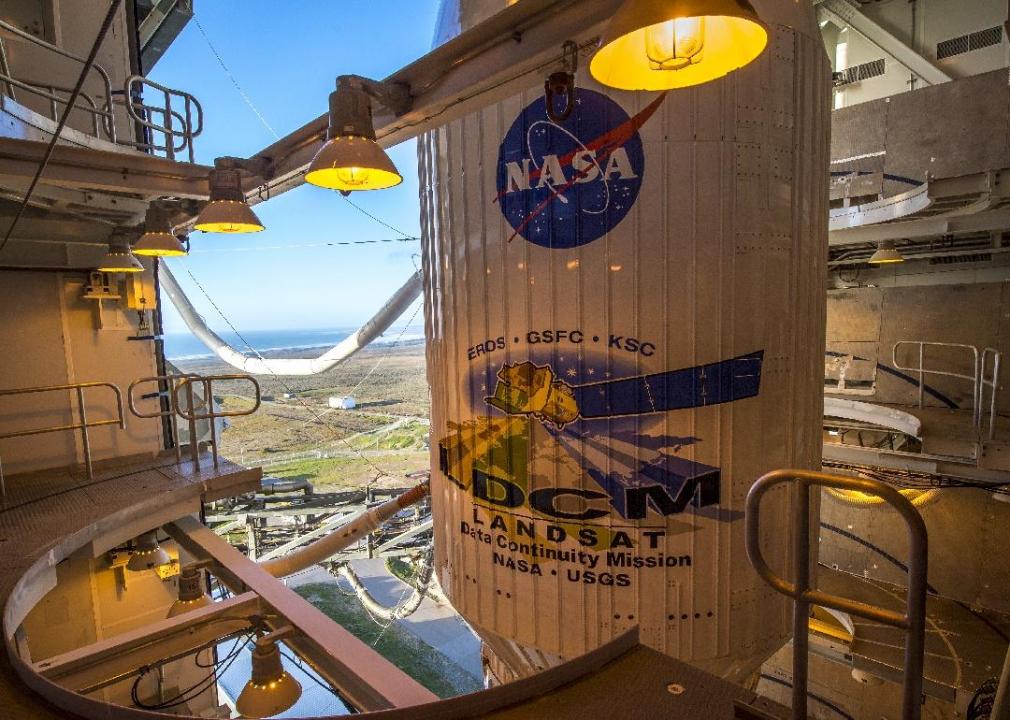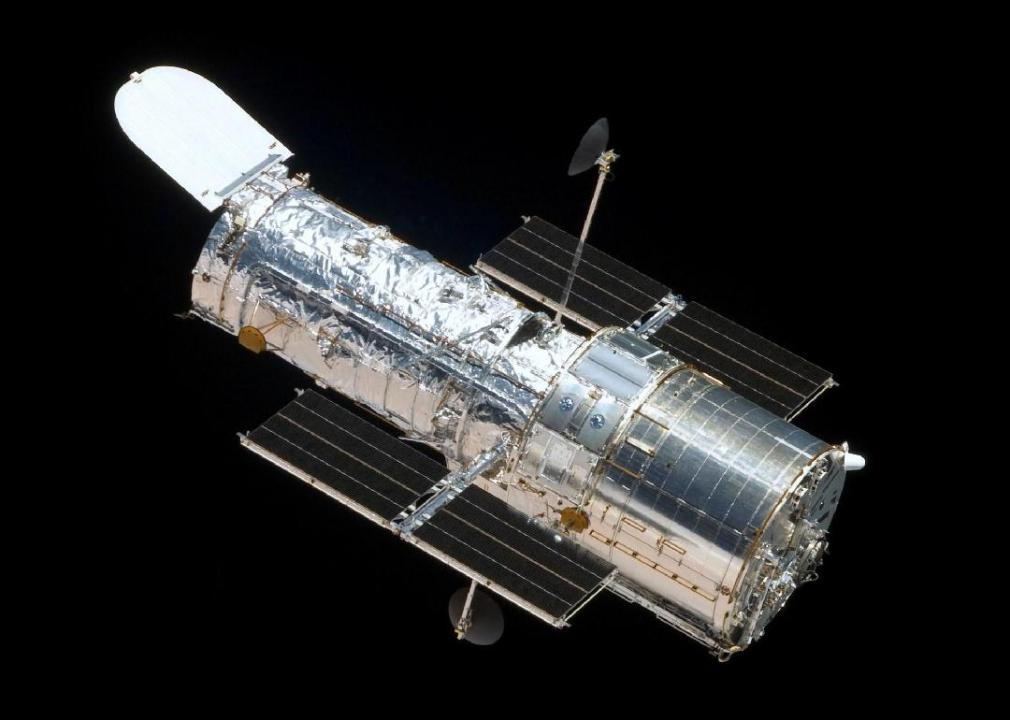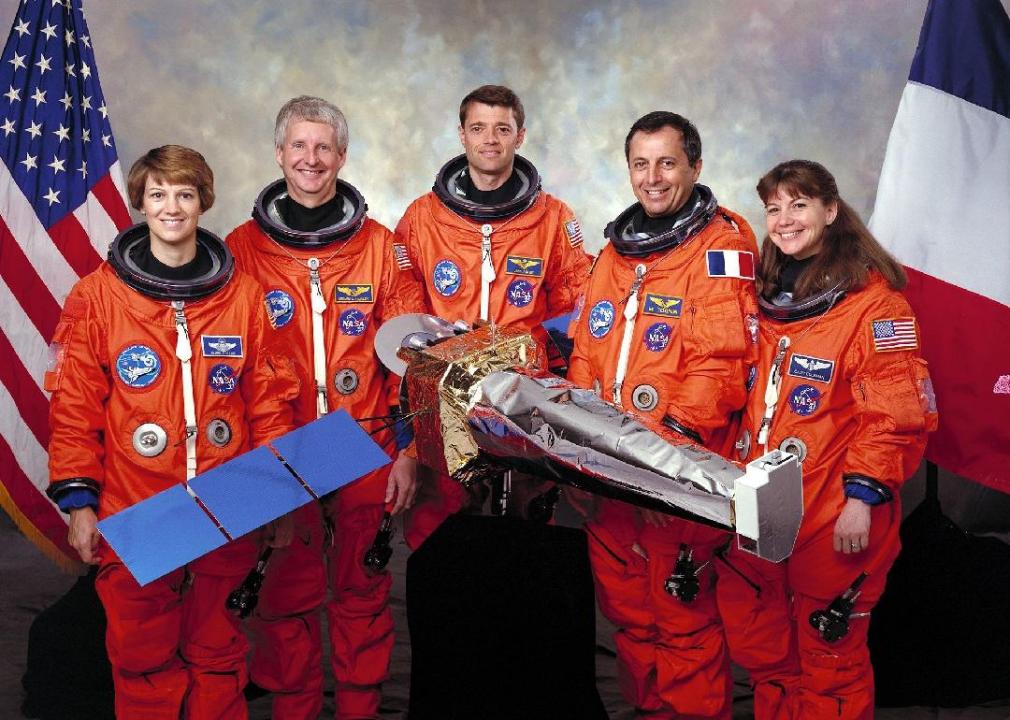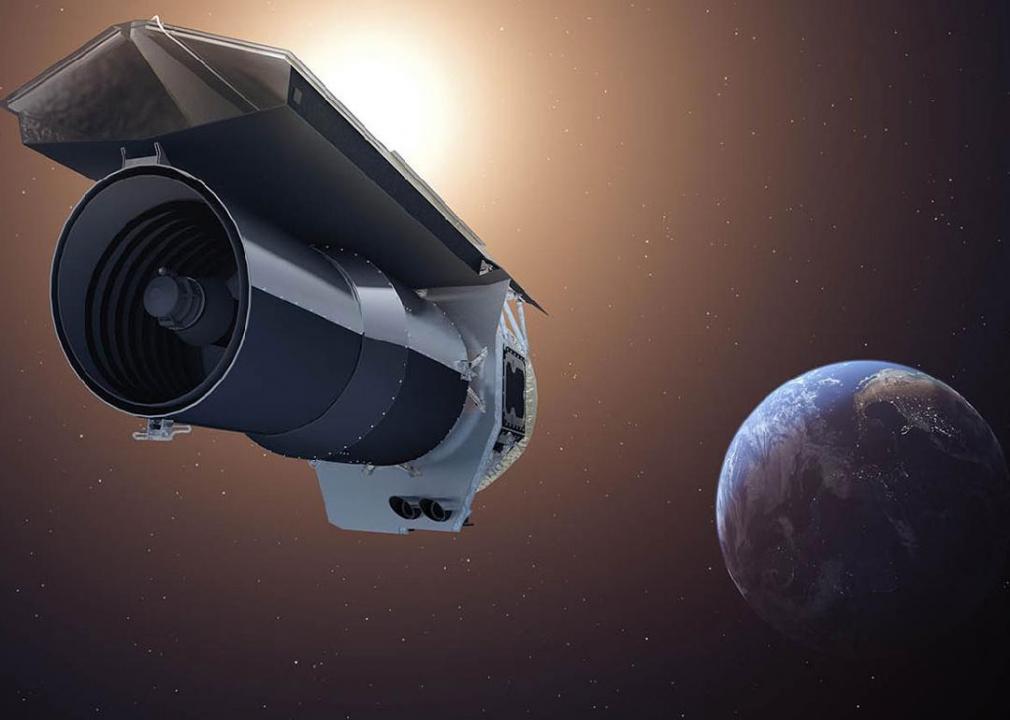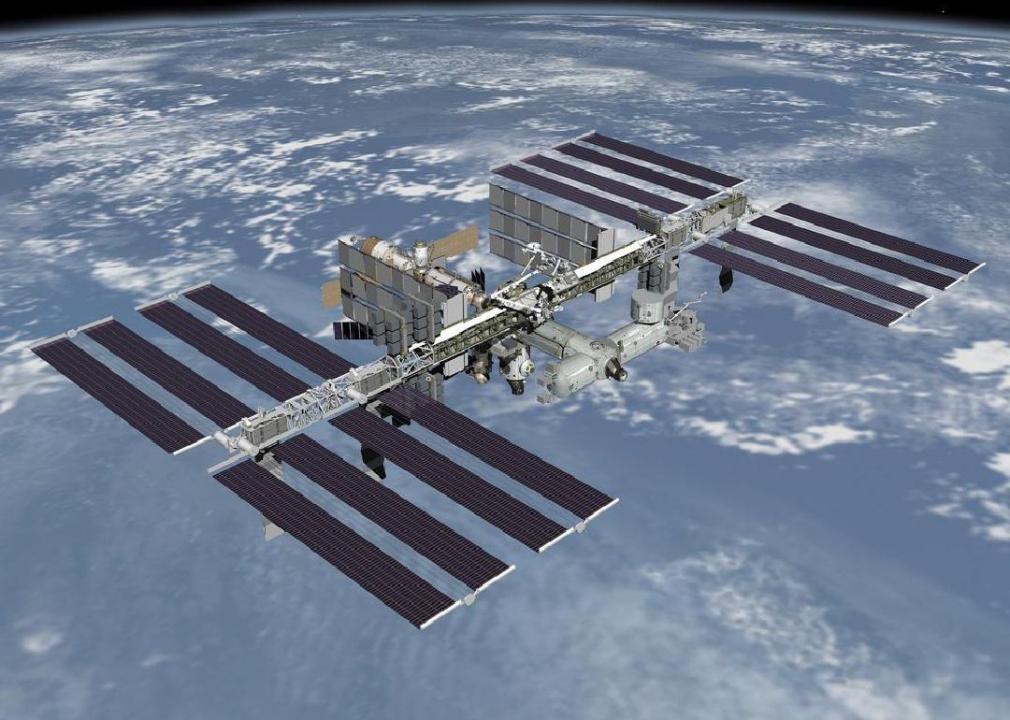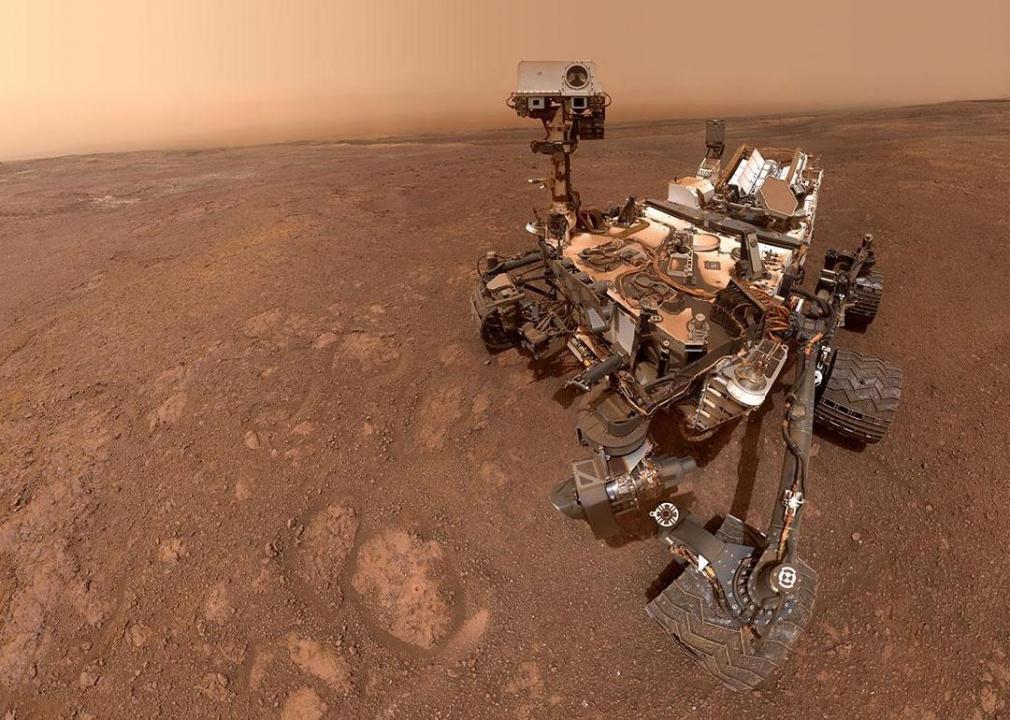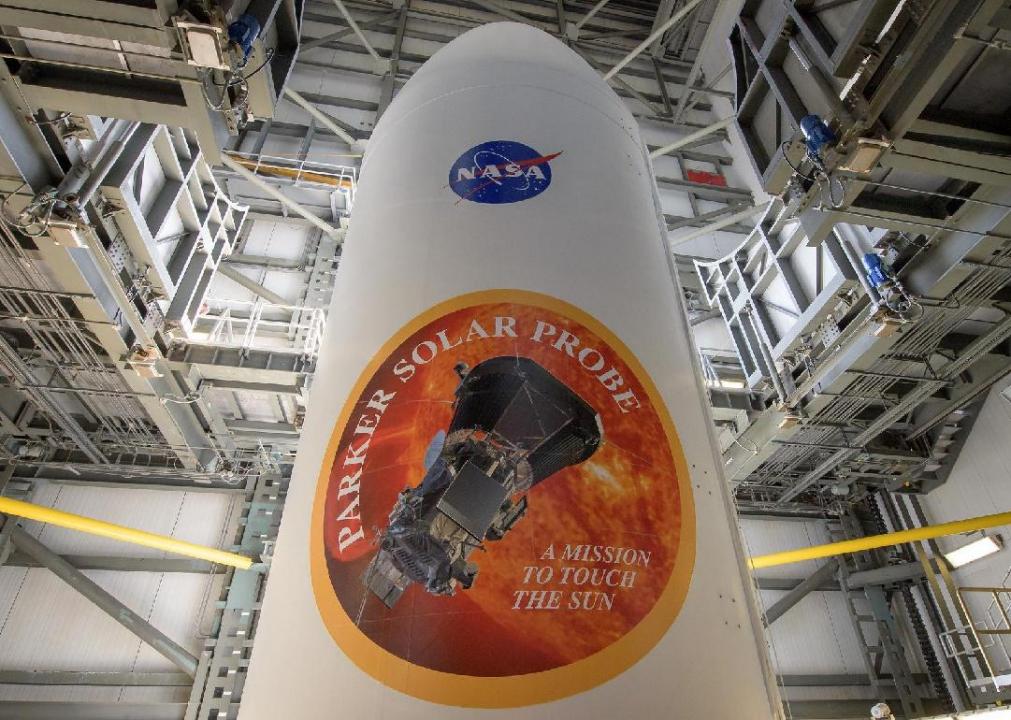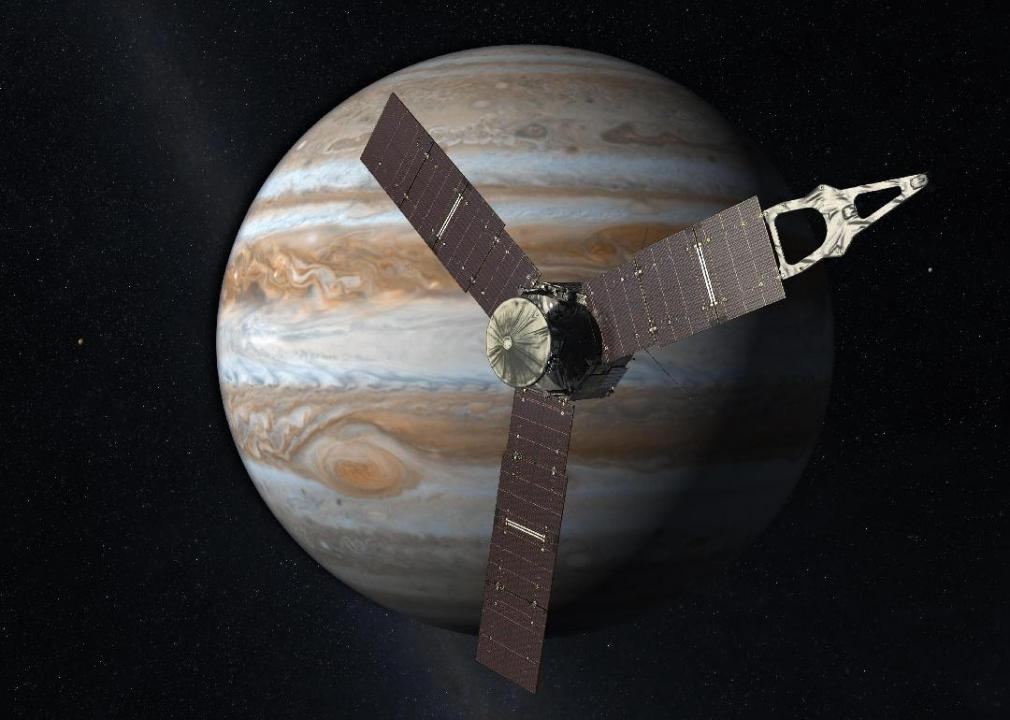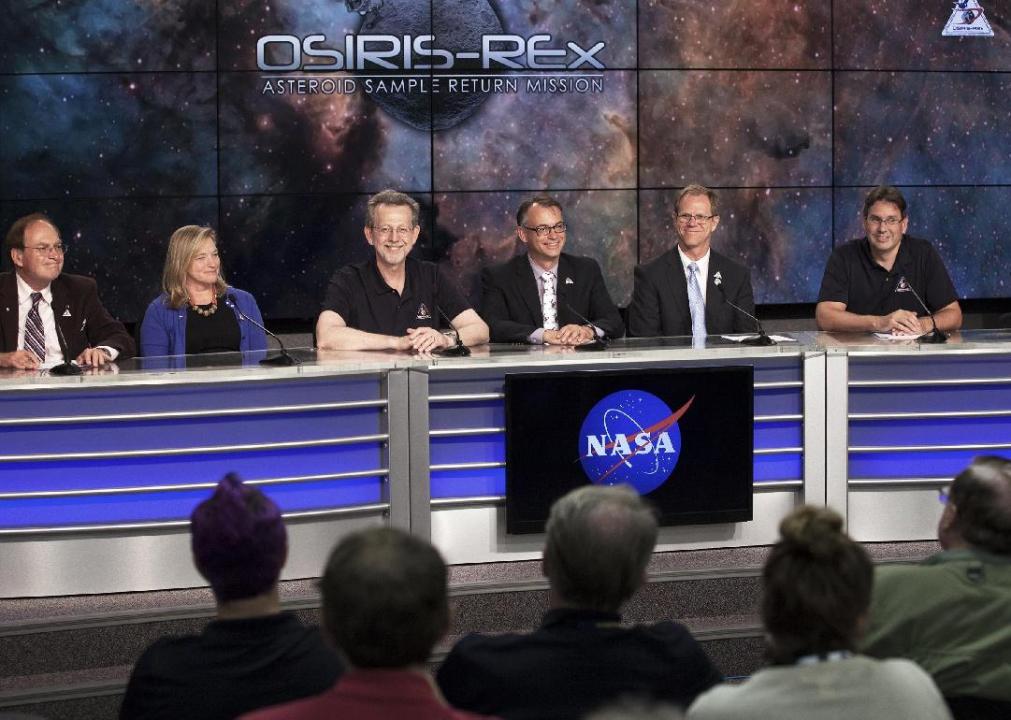33 groundbreaking NASA missions in photographs
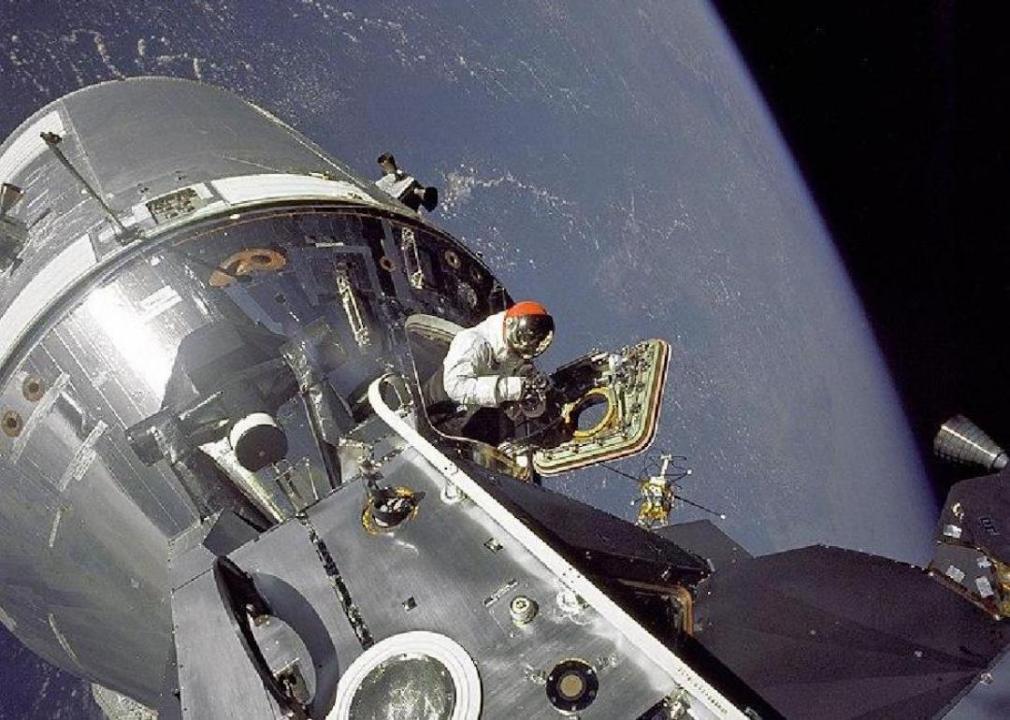
NASA // Wikimedia Commons
33 groundbreaking NASA missions in photographs
The universe is nearly 14 billion years old. Human existence makes up a tiny fraction of that time. If the history of Earth was made up of 24 hours, humans came into the picture just before 11:59 p.m.—and we’ve spent much of that time fascinated with space.
For so long, we have posited theories and done our best to reach the most distant corners of the universe. Sixteenth-century Mesopotamians envisioned space as a cosmic ocean. While under the reign of the Roman Empire, Ptolemy theorized a geocentric universe. In 2015, new evidence emerged supporting the existence of water on Mars, and more recently, space tourism has been a hot topic of conversation. People at all points in history have had ideas about what lies beyond the sky and have wanted both to understand and see it for themselves.
In honor of World Space Week, Stacker curated a gallery of groundbreaking NASA missions.
In the modern world, NASA is at the forefront of space exploration, making knowledge of the great unknown even more possible. Founded in 1958 and headquartered in Washington D.C., NASA quickly changed the course of both robotic and human spaceflight. Since its creation, the agency has put people on the moon, created new windows into viewing the universe, and discovered extrasolar planets, among other things. And as it turns out, the people doing all this incredible work are a little more down-to-Earth than the general public may believe. While some might be geniuses, they’re also simply curious human beings.
The forthcoming images depict some of NASA’s most profound achievements and capture these missions in a way that is at once visually profound and scientifically meaningful. Read on to learn about some of the most incredible moments and missions in NASA history.
You might also like: 30 spectacular images of Earth from space
![]()
NASA
Explorer 1
In 1958, the launch of Explorer 1 marked a crucial turning point: this was the first time the United States succeeded in launching a satellite into space. The Soviet Union had launched Sputnik 1 in late 1957, and Explorer 1 showcased the fact that the United States was very much a contender in the space race. Explorer 1 transmitted signals to Earth for just under four months and was destroyed years later, in 1970, when it reentered Earth’s atmosphere.
NASA // Flickr
Apollo-Saturn
Before NASA put anyone on the moon or even sent anyone into space, it needed to create and test a spacecraft that was up to the task. Thus, the Saturn V was born. This rocket, the kind that eventually would carry Neil Armstrong and Buzz Aldrin to the moon, was tested in stages throughout the 1960s and underwent its first full unmanned test flight in 1967, becoming the first-ever launch from the Kennedy Space Center in Florida.
Testing an entire rocket at once via a launch—rather than testing various aspects incrementally—was a novel approach, and then-Space Center Director Dr. Kurt H. Debus commented afterward that it “went extremely well.“
NASA
Apollo 7
By October 11, 1968, when Apollo 7 launched from Cape Canaveral in Florida, humans had already spent some time in space—the first among them being Yuri Gagarin of the Soviet Union. However, Apollo 7 orbited Earth 163 times over nearly 11 days, making it the longest trip thus far and breaking additional barriers by being the first manned spaceship to broadcast live on national TV. The successful goal of this mission was to both test the ship’s equipment and to ensure that the three crew members could survive a trip this long.
NASA // Wikimedia Commons
Apollo 8
Some may think Christmas with the in-laws is tough, but the crew of Apollo 8, who spent their 1968 Christmas in space, would likely beg to differ. The Apollo 8 mission was intended to test both the spacecraft and the crew in an orbit between the Earth and the moon (referred to as cislunar), and an orbit around the moon , which had never before been done. The mission went well, proving the technology new to this spacecraft, such as a combined forward hatch, was in good shape and ready for further use and development.
You may also like: The best streaming services in 2021
NASA // Wikimedia Commons
Apollo 9
While Apollo 8 successfully orbited the moon, it did not land, and additional testing was required to ensure that astronauts could visit the moon and return home safely. Enter the 1969 Apollo 9 mission, in which a crew tried out a piece of technology crucial to this goal: the lunar landing module. The mission was a success, and the crew could reattach the landing module in space, proving that a trip to the moon was not far off.
NASA // Wikimedia Commons
Apollo 10
Often referred to as the “dress rehearsal” for the first lunar landing, the 1969 Apollo 10 mission essentially went through the motions of a moon landing, including detaching the lunar lander from the command module and putting it through the first portion of a descent, without actually touching down. The lunar lander and command module are respectively—and charmingly—referred to as Snoopy and Charlie Brown. Though everyone returned safely, the crew experienced a moment of panic when human error led the lunar module to spin wildly out of control (and the crew to shout a few choice expletives).
NASA // Getty Images
Apollo 11
Ladies and gentlemen, the moment we’ve all been waiting for: on July 16, 1969, a Saturn V rocket carrying Neil Armstrong, Michael Collins, and Buzz Aldrin launched from Kennedy Space Center. Four days later, Armstrong became the first human being to set foot on the moon. A new documentary about this event has shed light on some forgotten moments of the mission, such as Neil Armstrong taking the time, in a live TV broadcast during the crew’s return to Earth, to pay homage to the technicians and engineers who built the 363-foot rocket that would make history. Eight years after former President John F. Kennedy declared the lofty goal of putting a man on the moon, it was finally a reality.
NASA // Wikimedia Commons
Apollo 12
A few short months after the Apollo 11 mission put the first two men on the moon, the Apollo 12 mission followed suit. On November 19, 1969, Charles Conrad Jr. and Alan L. Bean became the third and fourth souls to set foot on the lunar surface, spending 32 hours there while third crew member Richard F. Gordon, II stayed on board the spacecraft. Mission goals included collecting data and samples from the lunar surface, setting up the Apollo Lunar Surface Experiments Package (which would be left there to gather additional information), and checking on Surveyor 3, an unmanned spacecraft that had landed there two years earlier.
NASA // Flickr
Apollo 13
Houston, we have a problem: While this widely known phrase is not entirely accurate (crew member John Swigert actually said, “OK, Houston, we’ve had a problem here”), it still summarizes what happened during the Apollo 13 mission. This mission was intended to be the third moon landing, but that goal had to be aborted when an oxygen tank exploded 56 hours into the flight. The three men on board—Swigert, Fred Haise, and Jim Lovell—were then forced to take shelter in the lunar module and quickly assemble an adapter that would make the air breathable, thus proving the possibility of a safe return to Earth even in the face of harrowing danger.
NASA // Flickr
Apollo 14
Part of Apollo 13’s objectives had been to land for the first time on a particular area of the moon known as Fra Mauro, a crater named for the 15th-century Italian geographer. Since Apollo 13 never landed, Apollo 14—which launched in early 1971 and carried a three-person crew of Alan Shepard, Stuart Roosa, and Edgar Mitchell—took over the goal of the Fra Mauro landing. After takeoff, the spacecraft struggled and experienced five failed attempts at connecting the command ship with the docking ring of the landing craft, but ultimately succeeded and completed the mission.
NASA // Flickr
Apollo 15
The July 1971 Apollo 15 mission was the fourth mission to put human beings on the moon. This mission marked the revolutionary debut of the lunar roving vehicle—also known as a “moon buggy”—a four-wheeled, open-air vehicle designed to function with the moon’s gravitational pull, thus enabling astronauts to observe a wider range of the lunar surface in a single visit. One aim of the trip was to take more photographs than in prior visits, so the crew of this mission traveled with a variety of cameras to capture scenes during every part of the journey.
NASA // Wikimedia Commons
Apollo 16
Beginning on April 16, 1972, the Apollo 16 mission lasted just over 11 days and carried the three-person crew of John Young, Thomas “Ken” Mattingly, and Charles Duke. Young and Duke set foot on the moon’s surface and spent over 20 hours there collecting, in an amazing feat, over 200 pounds of lunar samples. Duke also made history by leaving something behind: a family photo with this message written on the back: “This is the family of astronaut Charlie Duke from planet Earth who landed on the moon on April 20, 1972.”
You may also like: The best streaming services for football in 2021
NASA // Wikimedia Commons
Apollo 17
Apollo 17, which launched on December 7, 1972, marked the last time humans set foot on the moon; however, the legacy of this mission is still very much alive. NASA recently announced it would open a collection of lunar rocks from Apollo missions 15, 16, and 17 that had never been studied in full. The latter mission alone brought back 250 pounds of rocks. These samples were preserved for a time when more advanced technology could delve deeply into the clues they may hold, and the time to dig in has finally come.
NASA Ames Resarch Center // Wikimedia Commons
Pioneer 10
The journey of Pioneer 10, a space probe that launched from Cape Canaveral on March 2, 1972, was filled with firsts. At the time, NASA was gearing up to take advantage of a rare alignment in the solar system that would allow for a “Planetary Grand Tour”—meaning a group of spacecrafts could visit multiple planets in one trip. To prepare for this journey, Pioneer 10 was sent on a data-gathering mission and became the first spacecraft to reach Jupiter and the first to leave the inner solar system.
NASA Marshall Space Flight Center // Wikimedia Commons
Pioneer 11
Pioneer 11 served as a companion probe to Pioneer 10 and was launched into space in 1973. Pioneer 11’s journey marked another important first for NASA: this probe was the first to encounter Saturn, and it was also able to send back amazing images of Jupiter’s polar regions. The spacecraft experienced a few technical setbacks and failures on its outbound journey but overcame them and made such discoveries as an additional ring around Saturn. The last contact with this spacecraft occurred in late 1995.
NASA Jet Propulsion Laboratory
Viking
The central goal of NASA’s 1970s Viking missions was to gather images of and data pertaining to Mars, as knowledge of the planet was slim. The Viking project proved a huge success, producing some 50,000 images of Mars and disproving the theory that the Martian sky was blue, similar to that of Earth— it’s actually pinkish during daytime. Viking landers could also touch down and analyze Martian soil and atmosphere, a huge stepping stone in scientific understanding of this planet.
NASA // Getty Images
Voyager Interstellar
The space probe Voyager 2 was sent into space in 1977, and in late 2018 it exited the heliosphere—the region of space that surrounds the sun and is impacted by its magnetic field—and officially went interstellar. In the decades preceding this monumental moment, Voyager 2 encountered and photographed Jupiter, Neptune, Uranus, and Saturn; it is the only probe to face the latter two planets. Voyager 1 went interstellar in 2012, and now both probes are on a mission to send back information about what lies beyond the solar system, though they are still many thousands of years from reaching the stars for which they have set course.
You may also like: The best streaming services for sports in 2021
NASA // Flickr
Skylab
Skylab, NASA’s first space station, was made out of a component of a Saturn V rocket during a time of NASA budget constraints. It launched unmanned in May 1973. The goal was to test the viability, for the first time, of a space station a crew could inhabit for extended periods to conduct scientific research; in fact, several crews (one of which included Charles Conrad, a member of Apollo 12) visited and occupied the station during its time in space. Skylab’s return to Earth became an international media spectacle, as NASA could not pinpoint the exact moment when or location where the craft would crash back through the atmosphere.
You may also like: 30 breathtaking images from NASA’s public library
NASA // Flickr
Space Shuttle
NASA’s Space Shuttle Program—in effect from 1981 to 2011—marked a huge scientific stride in creating the first effectively reusable spacecraft. The program created a fleet of five spacecraft during its three-decade run, and before Space Shuttle Challenger’s tragic end, it carried Sally Ride, the first U.S. woman in space. Space Shuttle Discovery successfully carried 184 men and women to space and back and spent 365 days in space before it was retired in 2011.
NASA // Flickr
Shuttle-Mir
For much of the Cold War, the United States and the former Soviet Union used space to compete against one another, but the Shuttle-Mir program noted a great shift in this dynamic. The program was a U.S.-Russia collaboration, comprising U.S. shuttles and astronauts visiting the Russian space station, Mir. When the U.S. space shuttle Atlantis docked at Mir in 1995, history was made in more ways than one: The U.S. and Russian spacecraft together formed the biggest man-made satellite, and the trip itself made up this country’s 100th human space mission.
Bill Ingalls with NASA // Getty Images
Landsat
On July 23, 1971, Landsat 1 (originally named the Earth Resources Technology Satellite) was launched into space. The goal of the Landsat program was to obtain extensive satellite imagery of Earth’s terrain. Today, both Landsat 8, which began operating in 2013, and Landsat 9, which was launched in 2021, are active and functional. The program was heavily opposed at the start due to budget restrictions and the U.S. Department of Defense’s fear that such photography would negatively affect the confidentiality of the missions. But it was ultimately funded and became a successful and valuable program.
NASA
Hubble Space Telescope
The Hubble Space Telescope is named for Edwin Powell Hubble, a hugely important 20th-century American astronomer who discovered and proved the existence of galaxies beyond the Milky Way. The telescope was launched into orbit in 1990 and has since broken barriers through its unique ability to capture and transmit images of space. The telescope is used for extensive scientific research projects, such as the Frontier Fields program, but members of the public can also apply for observation time.
NASA // Wikimedia Commons
Chandra
Chandra X-ray Observatory, launched by NASA in 1999, is a telescope designed for detecting X-ray emissions in space. These emissions occur in the universe’s hottest regions, where stars explode, and Chandra has been groundbreaking in its ability to capture images of such phenomena. The telescope captured images of a 2019 galactic storm in a distant galaxy in a cosmic structure known as the “Teacup,” located over 1 billion light years from Earth.
NASA Jet Propulsion Laboratory
Spitzer Space Telescope
The Spitzer Space Telescope, which launched in 2003 and retired in 2020, was an infrared telescope that has allowed scientists visual access to previously unseen regions of the universe. The telescope is made up of two main components: the spacecraft itself and the cryogenic telescope assembly. It has produced striking images of brown dwarfs, molecular clouds, and more. Spitzer is notable for its role in scientists’ ability to identify exoplanets and has given insight into galaxies over 13 billion light-years from Earth.
NASA // Flickr
International Space Station
If you don’t enjoy spending extended periods of time with your coworkers, then a job on the International Space Station may not be for you. The Space Station, which launched into orbit in 1998, has been continuously inhabited, with crews generally staying on board for six months at a time. Many nations contribute crew members and scientific knowledge to the project, and the three members of the current Expedition 58—Oleg Kononenko, Anne McClain, and David Saint-Jacques—have been aboard since December 2018. This consistent presence of humans in space is groundbreaking in its own right and has allowed the scientific community to perform extensive experiments and gain knowledge about how humans can live in space.
NASA
Mars Science Laboratory
Since 2012, the Curiosity rover for the Mars Science Laboratory has been stationed on the red planet, trying to provide an answer to one specific question: Was Mars ever able to support life, specifically microscopic organisms known as microbes? Mars Science Laboratory’s mission is a subset of NASA’s Mars Exploration Program, designed to study the habitability of Mars and determine whether the planet could one day be a home for humans. Through its success in shedding light on Mars, Curiosity is living up to its name, which was bestowed by a 12-year-old named Clara Ma, who won Mars Science Laboratory’s essay contest in 2009.
NASA
Parker Solar Probe
Many spacecraft and brave astronauts have traveled the galaxy, but the Parker Solar Probe has embarked on a mission unlike anything that came before it. Launched in 2018, this probe will encounter unimaginably intense heat and radiation and is doing so to learn more about the sun’s outer corona —the aura of plasma surrounding it. Another detail that sets the Parker Solar Probe apart from all other NASA missions is that it’s the first to be named for a living individual: Eugene Newman Parker, a professor at the University of Chicago who theorized revolutionary concepts about how the sun emits energy.
NASA
Juno
Because of the dense layer of clouds that surrounds it, Jupiter maintains an environment that could shed light on the conditions in play when the solar system was first formed. This is the primary reason Juno is so important. Launched in 2011, it is the first probe to map Jupiter’s structure so far below the clouds. It can sample the charged particles on the planet’s poles, which have never been analyzed in such a way. Juno is the name of the Roman goddess who was able to see through clouds to check on her husband, Jupiter, which is perfectly fitting.
NASA
OSIRIS-REx
OSIRIS-REx’s mission is no small undertaking. This spacecraft—and those behind it at NASA—seeks answers to questions such as where humans come from and why the universe exists as it does. OSIRIS-REx was launched in 2016 and is currently traveling back to Earth with samples from asteroid Bennu, which was chosen for this mission because of its size, composition, and proximity. The great feat of OSIRIS-REx is that it’s on track to be the first mission to return an asteroid sample to Earth—on track for 2023.
NASA
Cassini-Huygens
Besides the great discoveries it provided, the Cassini-Huygens spacecraft also marked an act of unity in the name of science. This spacecraft, which traveled to Saturn carrying a probe known as Huygens, was a joint effort among NASA, the European Space Agency, and the Italian Space Agency. Cassini-Huygens’ mission lasted 20 years, and in that time it made many critical discoveries, including revelations about the gravitational pull of Saturn’s rings. Huygens also made the first landing on Titan, one of Saturn’s moons. Perhaps most impressively, the Cassini-Huygens mission ended with a grand finale: In its last months, Cassini-Huygens dove through the gap between Saturn and its rings 22 times, creating a well of data about this previously unexplored region.
You may also like: Space discoveries that will blow your mind
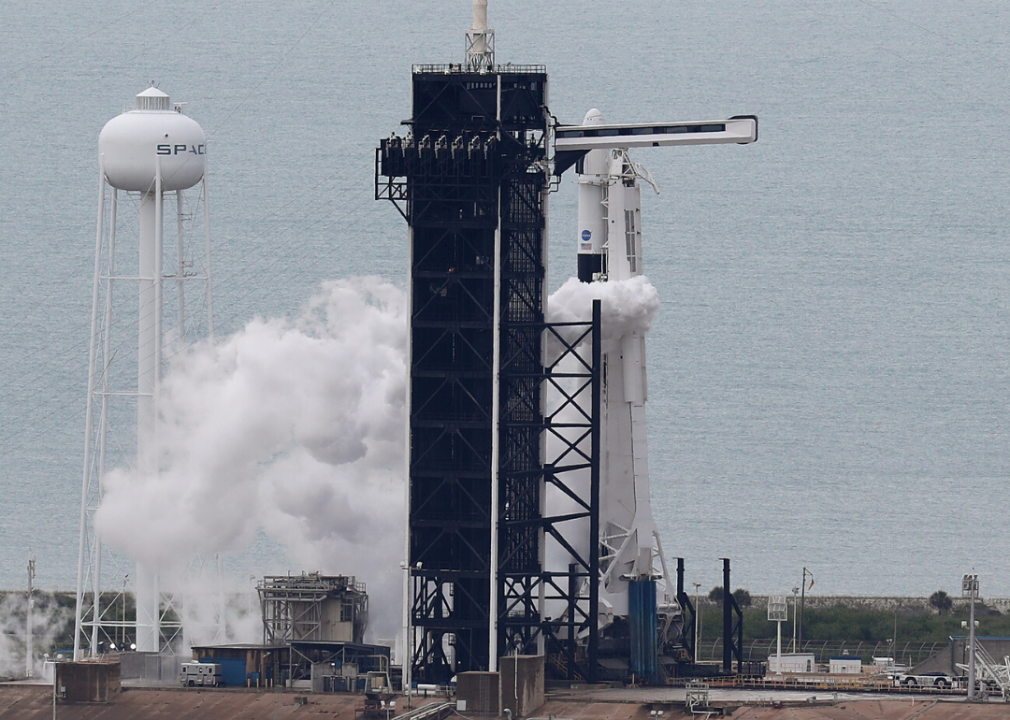
Joe Raedle // Getty Images
SpaceX Falcon 9 Rocket and Manned Crew
Elon Musk’s SpaceX is going where no private company has gone before: to space. The mission, representing the first astronaut trip to space since 2011, is part of NASA’s Commercial Crew Program. The Crew Dragon spacecraft had astronauts Robert Behnken and Douglas Hurley on board when it took off from Launch Complex 39A in Florida on a Falcon 9 rocket on May 30, 2020.
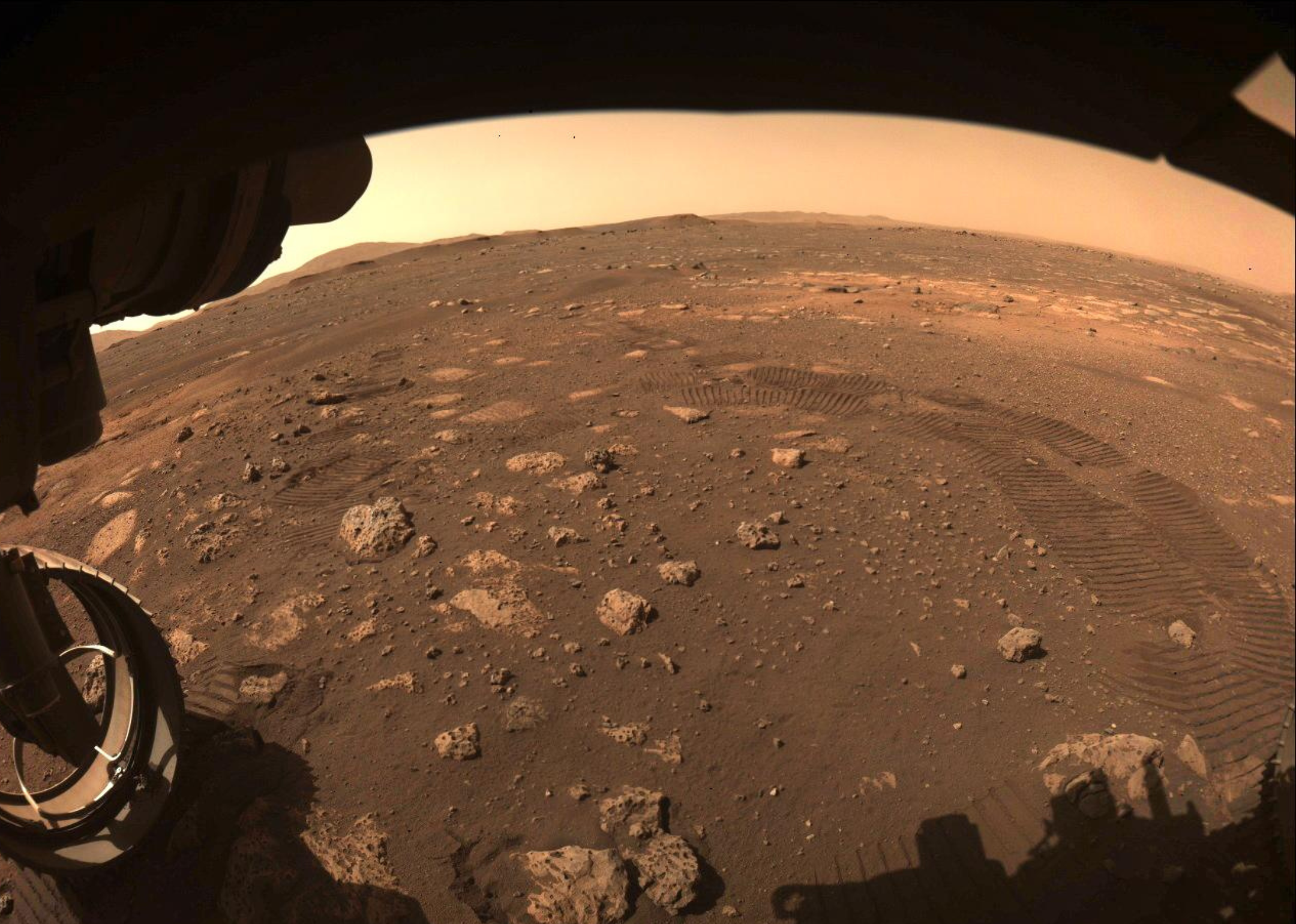
NASA/JPL-Caltech
Mars 2020 Perseverance rover and Ingenuity helicopter
NASA’s Mars Exploration program launched the Perseverance rover in July 2020 as part of a multi-year program to collect organic samples and search for signs of life on the Red Planet. Fastened to the rover was a helicopter named Ingenuity, tasked with testing flight capabilities on Mars.
Perseverance has since revealed different types of rock present in Jezero Crater—including volcanic rock types that had, at some point, been in contact with water. Ingenuity has demonstrated that flight is, indeed, possible on Mars, having flown dozens of successful test flights.
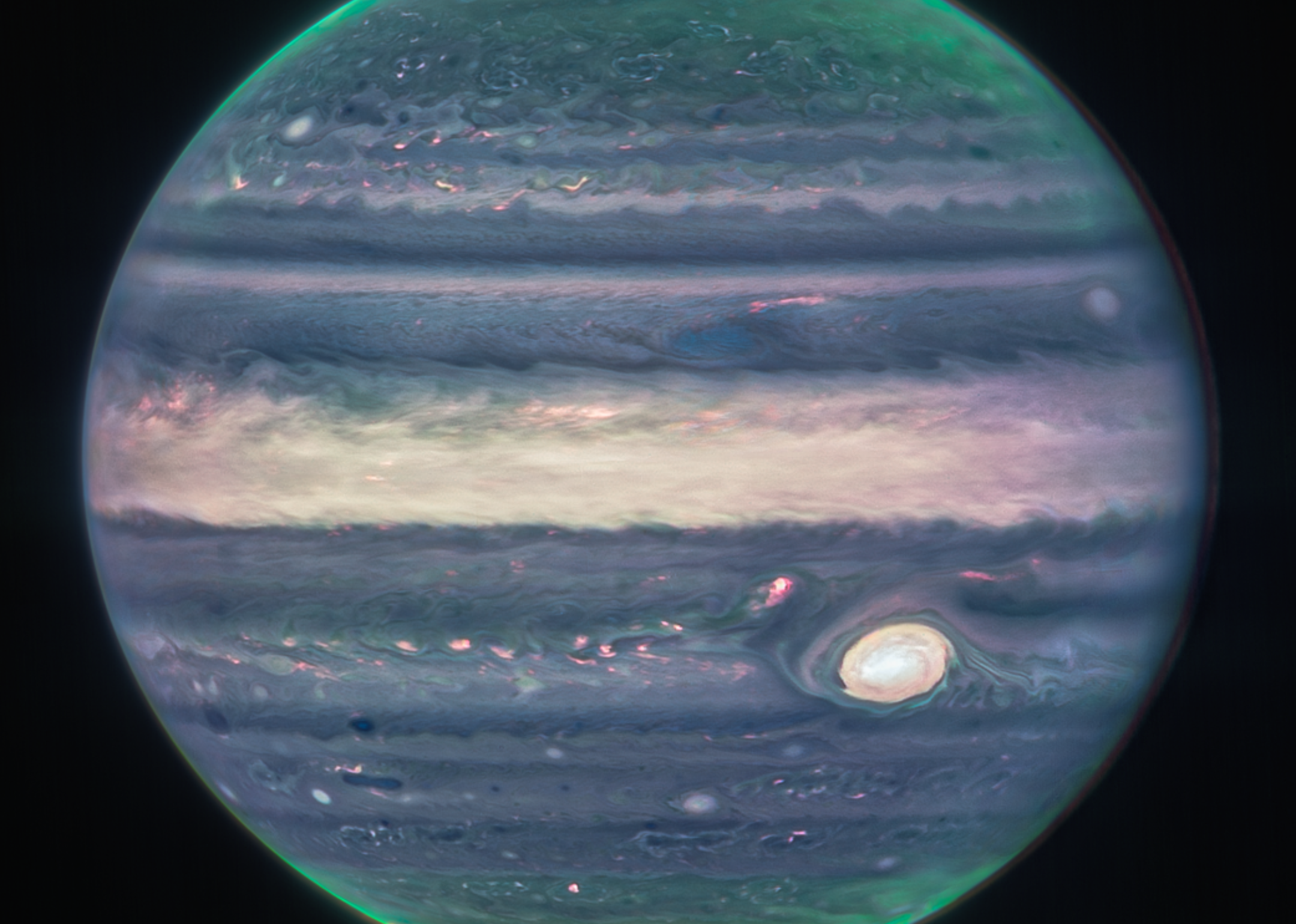
NASA, ESA, CSA, Jupiter ERS Team; image processing by Judy Schmidt
James Webb Space Telescope
After many delays, the James Webb Space Telescope launched on December 25, 2021. The telescope uses infrared wavelengths to see further into the universe than we’ve ever been able to see before and is expected to provide invaluable information on the formation of galaxies in the early universe.
Since its launch, Webb has already sent back images of the oldest galaxy ever seen, clear views of the rings around Neptune, and detailed images of Jupiter. It has also aided in the discovery of carbon dioxide on an exoplanet.
